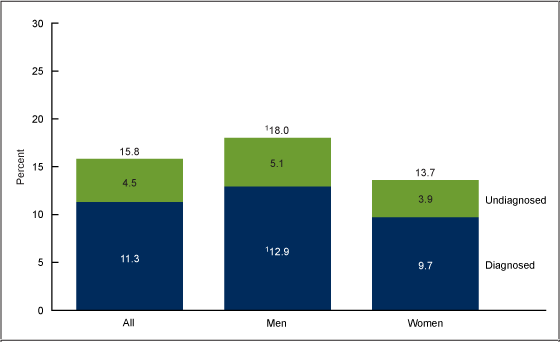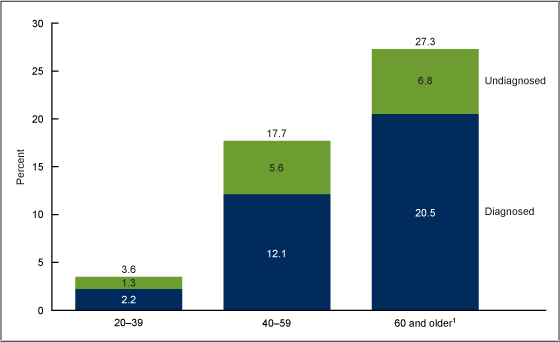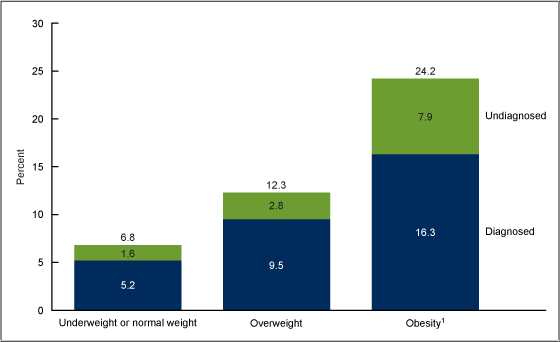Prevalence of Total, Diagnosed, and Undiagnosed Diabetes in Adults: United States, August 2021–August 2023
NCHS Data Brief No. 516, November 2024
PDF Version (548 KB)
Jane A. Gwira, M.D., M.P.H., Cheryl D. Fryar, M.S.P.H., and Qiuping Gu, M.D., Ph.D.
- Key findings
- During August 2021–August 2023, the prevalence of total and diagnosed diabetes was higher in men than in women.
- The prevalence of total, diagnosed, and undiagnosed diabetes increased with age.
- The prevalence of total, diagnosed, and undiagnosed diabetes increased with increasing weight status.
- The prevalence of total and diagnosed diabetes decreased with increasing levels of educational attainment
Data from the National Health and Nutrition Examination Survey
- During August 2021–August 2023, the prevalence of total diabetes was 15.8%, diagnosed diabetes was 11.3%, and undiagnosed diabetes was 4.5% in U.S. adults.
- Total and diagnosed diabetes prevalence was higher in men (18.0% and 12.9%, respectively) than in women (13.7% and 9.7%, respectively).
- Total, diagnosed, and undiagnosed diabetes prevalence increased with age.
- Total, diagnosed, and undiagnosed diabetes prevalence increased with increasing weight status.
- Total and diagnosed diabetes prevalence decreased with increasing educational attainment.
- The age-adjusted prevalence of total and diagnosed diabetes increased between 1999–2000 and August 2021–August 2023.
Diabetes mellitus is a chronic disease and metabolic disorder resulting in elevated blood glucose levels. It is categorized as type 1 or type 2 diabetes, gestational diabetes, and other specific types due to other causes (1). Uncontrolled blood glucose levels over a long period of time can affect multiple organ systems, including the nervous system, kidneys, eyes, heart, and blood vessels (2). Diabetes is a major cause of morbidity and mortality in the United States (3). This report presents the prevalence of diagnosed, undiagnosed, and total diabetes (excluding gestational diabetes) in U.S. adults during August 2021–August 2023.
Keywords: fasting plasma glucose, hemoglobin A1c, National Health and Nutrition Examination Survey (NHANES)
During August 2021–August 2023, the prevalence of total and diagnosed diabetes was higher in men than in women.
- The prevalence of total diabetes was 15.8% in all adults. The prevalence of diagnosed and undiagnosed diabetes was 11.3% and 4.5%, respectively (Figure 1, Table 1).
- Men had a higher prevalence of total and diagnosed diabetes (18.0% and 12.9%, respectively) compared with women (13.7% and 9.7%).
- The observed difference in undiagnosed diabetes between men and women was not significant.
Figure 1. Prevalence of total, diagnosed, and undiagnosed diabetes in adults age 20 and older, by sex: United States, August 2021–August 2023

1Significantly different from women (p < 0.05).
NOTES: Diagnosed and undiagnosed diabetes may not sum to total due to rounding. Estimates for diagnosed diabetes are based on responses to the survey question, “Other than during pregnancy, have you ever been told by a doctor or health professional that you have diabetes or sugar diabetes?” Estimates for undiagnosed diabetes are based on an 8- to 24-hour fasting plasma glucose greater than or equal to 126 mg/dL or hemoglobin A1c greater than or equal to 6.5% in a participant who reported never receiving a diabetes diagnosis from a healthcare provider. Age-adjusted estimates for adults age 20 and older are total diabetes: 14.3% all, 16.6% men, and 12.2% women; diagnosed diabetes: 10.1% all, 11.7% men, and 8.6% women; and undiagnosed diabetes: 4.2% all, 4.9% men, and 3.5% women, age adjusted by the direct method to the U.S. Census 2000 population using age groups 20–39, 40–59, and 60 and older.
SOURCE: National Center for Health Statistics, National Health and Nutrition Examination Survey, August 2021–August 2023.
The prevalence of total, diagnosed, and undiagnosed diabetes increased with age.
- The prevalence of total diabetes increased from 3.6% in adults ages 20–39 to 17.7% for ages 40–59 and 27.3% for age 60 and older (Figure 2, Table 2).
- The prevalence of diagnosed diabetes increased from 2.2% in adults ages 20–39 to 12.1% for ages 40–59 and 20.5% for age 60 and older.
- The prevalence of undiagnosed diabetes increased from 1.3% in adults ages 20–39 to 5.6% for ages 40–59 and 6.8% for age 60 and older.
Figure 2. Prevalence of total, diagnosed, and undiagnosed diabetes in adults age 20 and older, by age group: United States, August 2021–August 2023

1Significant increasing linear trend for total, diagnosed, and undiagnosed diabetes (p < 0.05).
NOTES: Diagnosed and undiagnosed diabetes may not sum to total due to rounding. Estimates for diagnosed diabetes are based on responses to the survey question, “Other than during pregnancy, have you ever been told by a doctor or health professional that you have diabetes or sugar diabetes?” Estimates for undiagnosed diabetes are based on an 8- to 24-hour fasting plasma glucose greater than or equal to 126 mg/dL or hemoglobin A1c greater than or equal to 6.5% in a participant who reported never receiving a diabetes diagnosis from a healthcare provider.
SOURCE: National Center for Health Statistics, National Health and Nutrition Examination Survey, August 2021–August 2023.
The prevalence of total, diagnosed, and undiagnosed diabetes increased with increasing weight status.
- The prevalence of total diabetes increased from 6.8% in adults in the underweight or normal weight category to 12.3% in those in the overweight category and 24.2% in adults with obesity (Figure 3, Table 3).
- The prevalence of diagnosed diabetes increased from 5.2% in adults in the underweight or normal weight category to 9.5% in those in the overweight category and 16.3% in adults with obesity.
- The prevalence of undiagnosed diabetes increased from 1.6% in adults in the underweight or normal weight category to 2.8% in those in the overweight category and 7.9% in adults with obesity.
Figure 3. Prevalence of total, diagnosed, and undiagnosed diabetes in adults age 20 and older, by weight status: United States, August 2021–August 2023

1Significant increasing linear trend for total, diagnosed, and undiagnosed diabetes (p < 0.05)
NOTES: Estimates for diagnosed diabetes are based on responses to the survey question, “Other than during pregnancy, have you ever been told by a doctor or health professional that you have diabetes or sugar diabetes?” Estimates for undiagnosed diabetes are based on an 8- to 24-hour fasting plasma glucose greater than or equal to 126 mg/dL or hemoglobin A1c greater than or equal to 6.5% in a participant who reported never receiving a diabetes diagnosis from a healthcare provider. Body mass index is weight in kilograms divided by height in meters squared. Weight status categories are defined as underweight or normal weight, body mass index less than 25.0; overweight, body mass index 25.0–29.9; and obesity, body mass index 30.0 or more.
SOURCE: National Center for Health Statistics, National Health and Nutrition Examination Survey, August 2021–August 2023.
The prevalence of total and diagnosed diabetes decreased with increasing levels of educational attainment.
- The prevalence of total diabetes decreased from 19.6% in adults with a high school degree, GED, or less to 17.2% in those with some college education and 10.7% in adults with a bachelor’s degree or more (Figure 4, Table 4).
- The prevalence of diagnosed diabetes decreased from 14.6% in adults with a high school degree, GED, or less to 12.0% in those with some college education and 7.3% in adults with a bachelor’s degree or more.
- No significant differences were seen by educational attainment for those with undiagnosed diabetes.
Figure 4. Prevalence of total, diagnosed, and undiagnosed diabetes in adults age 20 and older, by educational attainment: United States, August 2021–August 2023

1Significant decreasing linear trend (p < 0.05).
NOTES: Estimates are weighted using fasting sample weights. Estimates for diagnosed diabetes are based on responses to the survey question, “Other than during pregnancy, have you ever been told by a doctor or health professional that you have diabetes or sugar diabetes?” Estimates for undiagnosed diabetes are based on an 8- to 24-hour fasting plasma glucose greater than or equal to 126 mg/dL or hemoglobin A1c greater than or equal to 6.5% in a participant who reported never receiving a diabetes diagnosis from a healthcare provider.
SOURCE: National Center for Health Statistics, National Health and Nutrition Examination Survey, August 2021–August 2023.
The age-adjusted prevalence of total and diagnosed diabetes increased between 1999–2000 and August 2021–August 2023.
- The age-adjusted prevalence of total diabetes increased from 9.7% in 1999–2000 to 14.3% in August 2021–August 2023 (Figure 5, Table 5).
- The age-adjusted prevalence of diagnosed diabetes increased from 5.9% in 1999–2000 to 10.1% in August 2021–August 2023.
- From 1999–2000 through August 2021–August 2023, the age-adjusted prevalence of undiagnosed diabetes did not change significantly.
- Between 2017–March 2020 and August 2021–August 2023, no significant differences were seen in age-adjusted prevalence of total (14.8% to 14.3%), diagnosed (10.6% to 10.1%), and undiagnosed (4.2% each) diabetes.
Figure 5. Trends in age-adjusted prevalence of total, diagnosed, and undiagnosed diabetes in adults age 20 and older: United States, 1999–2000 through August 2021–August 2023

1Significant increasing linear trend (p < 0.05).
NOTES: Fasting glucose values were adjusted using forward regression equations provided by the National Center for Health Statistics. Estimates for diagnosed diabetes are based on responses to the survey question, “Other than during pregnancy, have you ever been told by a doctor or health professional that you have diabetes or sugar diabetes?” Estimates for undiagnosed diabetes are based on an 8- to 24-hour fasting plasma glucose greater than or equal to 126 mg/dL or hemoglobin A1c greater than or equal to 6.5% in a participant who reported never receiving a diabetes diagnosis from a healthcare provider. Estimates are age adjusted by the direct method to the U.S. Census 2000 population using the age groups 20–39, 40–59, and 60 and older.
SOURCE: National Center for Health Statistics, National Health and Nutrition Examination Surveys, 1999–2000 through August 2021–August 2023.
Summary
During August 2021–August 2023, the prevalence of total diabetes was 15.8%, diagnosed diabetes was 11.3%, and undiagnosed diabetes was 4.5%. Consequently, slightly more than one-quarter of adults with diabetes had undiagnosed diabetes. Men had a higher prevalence of total and diagnosed diabetes than women. Total, diagnosed, and undiagnosed diabetes prevalence increased with age and increasing weight status. The prevalence of total and diagnosed diabetes decreased with increasing educational attainment. The age-adjusted prevalence of total and diagnosed diabetes increased over time, from 1999–2000 through August 2021–August 2023. Continued monitoring of both diagnosed and undiagnosed diabetes will provide essential information about the prevalence of diabetes in adults in the United States.
Definitions
Diagnosed diabetes: Defined as the survey respondent answering yes to the question: “Other than during pregnancy, have you ever been told by a doctor or health professional that you have diabetes or sugar diabetes?”
Undiagnosed diabetes: Defined as the survey respondent reporting never having received a diabetes diagnosis from a healthcare provider and 8- to 24-hour fasting plasma glucose greater than or equal to 126 mg/dL or hemoglobin A1c greater than or equal to 6.5%.
Total diabetes: Combined prevalence of diagnosed and undiagnosed diabetes.
Weight status: Body mass index is calculated as weight in kilograms divided by height in meters squared. Normal or underweight is defined as a body mass index less than 25. Overweight is defined as a body mass index greater than or equal to 25 but less than 30. Obesity is defined as a body mass index greater than or equal to 30.
Data source and methods
Data from the August 2021–August 2023 National Health and Nutrition Examination Survey were used for analysis. The survey has a cross-sectional, complex, multistage probability sample design representative of the U.S. civilian noninstitutionalized population. The survey consists of interviews conducted in participants’ homes. Standardized health examinations and laboratory tests on blood and other specimens were conducted in mobile examination centers. However, due to the COVID-19 pandemic, survey operations were altered. Details of these changes in program and collection procedures can be found in the “Plan and Operations of the National Health and Nutrition Examination Survey, August 2021–August 2023” (4).
Criteria from the American Diabetes Association were used to define diabetes (1). Fasting plasma glucose data after an 8- to 24-hour fast were used. Fasting sample weights were used to account for differential probabilities of selection, nonresponse, and noncoverage. Analyses excluded pregnant women.
Standard errors of percentages were estimated using Taylor series linearization. Pairwise differences between groups were evaluated using t statistics. Stated differences were statistically significant at p less than 0.05. Orthogonal contrasts were used to test for linear trends across categories of age, educational attainment, and weight status. Linear regression models were used to evaluate linear and quadratic trends across survey timepoints from 1999–2000 through August 2021–August 2023 (adjusting for differential time between survey cycles) and adjusted for age. Fasting plasma glucose values were adjusted using forward regression equations provided by the National Center for Health Statistics (5–7). Statistical analyses were conducted using SAS release 9.4 (SAS Institute Inc., Cary, N.C.) and SAS-callable SUDAAN release 11.0 (RTI International, Research Triangle Park, N.C.).
About the authors
Jane A. Gwira was a Centers for Disease Control and Prevention Preventive Medicine resident at the National Center for Health Statistics, Division of Health and Nutrition Examination Surveys, during the analysis and writing of this report. Cheryl D. Fryar and Qiuping Gu are with the National Center for Health Statistics, Division of Health and Nutrition Examination Surveys.
References
- American Diabetes Association. Diagnosis and classification of diabetes: Standards of care in diabetes—2024. Diabetes Care 47(Supp1):S20–S42. 2024.
- Beagley J, Guariguata L, Weil C, Motala AA. Global estimates of undiagnosed diabetes in adults. Diabetes Res Clin Pract 103(2):150–60. 2014.
- Heron M. Deaths: Leading causes for 2016. National Vital Statistics Reports; vol 67 no 6. Hyattsville, MD: National Center for Health Statistics. 2018.
- Terry AL, Chiappa MM, McAllister J, Woodwell DA, Graber JE. Plan and operations of the National Health and Nutrition Examination Survey, August 2021–August 2023. National Center for Health Statistics. Vital Health Stat 1(66). 2024. DOI: https://dx.doi.org/10.15620/cdc/151927.
- National Center for Health Statistics. National Health and Nutrition Examination Survey: 2005–2006 data documentation, codebook, and frequencies—plasma fasting glucose & insulin (GLU_D). 2008.
- National Center for Health Statistics. National Health and Nutrition Examination Survey: 2007–2008 data documentation, codebook, and frequencies, plasma fasting glucose & insulin (GLU_E). 2010.
- National Center for Health Statistics. National Health and Nutrition Examination Survey: 2015–2016 data documentation, codebook, and frequencies, plasma fasting glucose (GLU_I). 2018.
Suggested citation
Gwira JA, Fryar CD, Gu Q. Prevalence of total, diagnosed, and undiagnosed diabetes in adults: United States, August 2021–August 2023. NCHS Data Brief, no 516. Hyattsville, MD: National Center for Health Statistics. 2024. DOI: https://dx.doi.org/10.15620/cdc/165794.
Copyright information
All material appearing in this report is in the public domain and may be reproduced or copied without permission; citation as to source, however, is appreciated.
National Center for Health Statistics
Brian C. Moyer, Ph.D., Director
Amy M. Branum, Ph.D., Associate Director for Science
Division of Health and Nutrition Examination Surveys
Alan E. Simon, M.D., Director
Lara J. Akinbami, M.D., Associate Director for Science